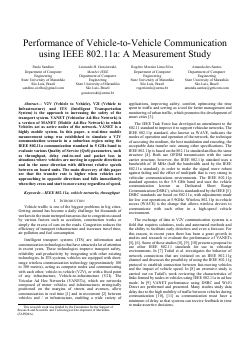
Performance of Vehicle-to-Vehicle Communication using IEEE 802.11a: A Measurement Study
Paulo Sandino, Leonardo Henrique Gonsioroski, Amanda Beatriz Cunha dos Santos, Rogerio Silva
DOI: 10.14209/sbrt.2022.1570800252
Evento: XL Simpósio Brasileiro de Telecomunicações e Processamento de Sinais (SBrT2022)
Keywords: IEEE 802.11a vehicle networks throughput
Abstract
V2V (Vehicle to Vehicle), V2I (Vehicle to Infrastructure) and ITS (Intelligent Transportation System) is the approach to increasing the safety of the transport system. VANET (Vehicular Ad-Hoc Network) is a version of MANET (Mobile Ad-Hoc Network) in which Vehicles act as active nodes of the network. VANET is a highly mobile system. In this paper, a real-time mobile measurement setup was established to simulate a V2V communication scenario in a suburban region using the IEEE 802.11a communication standard in 5 GHz band to evaluate various Quality of Service (QoS) parameters, such as throughput, delay end-to-end and packet loss in situations where vehicles are moving in opposite directions and in the same direction with different relative speeds between OBUs. The main discovery of this paper are that the transfer rate is higher when vehicles are approaching in opposite directions and falls immediately when they cross and start to move away regardless of speed.Download